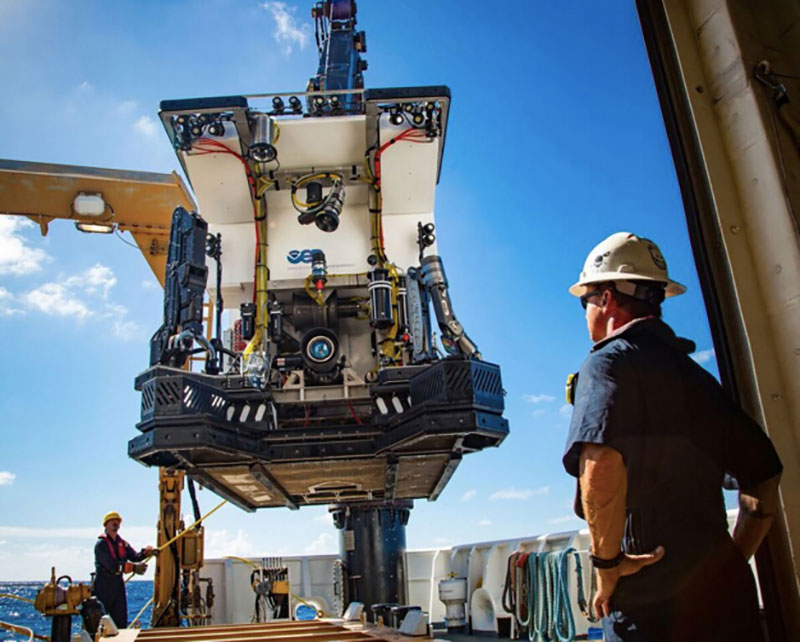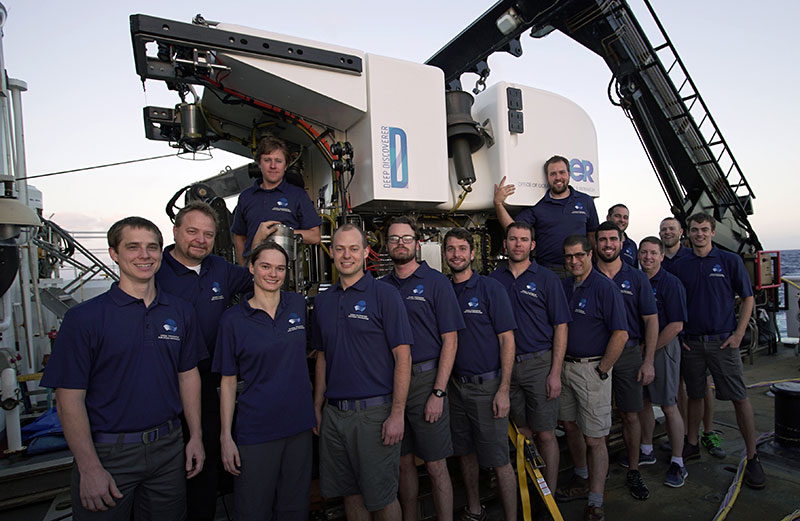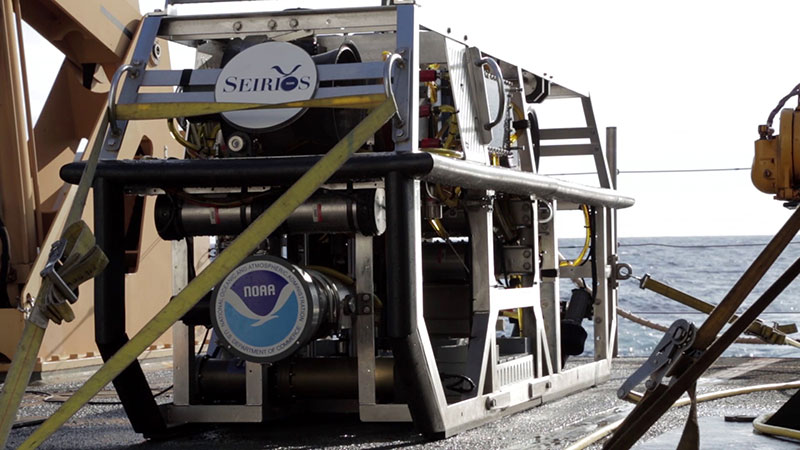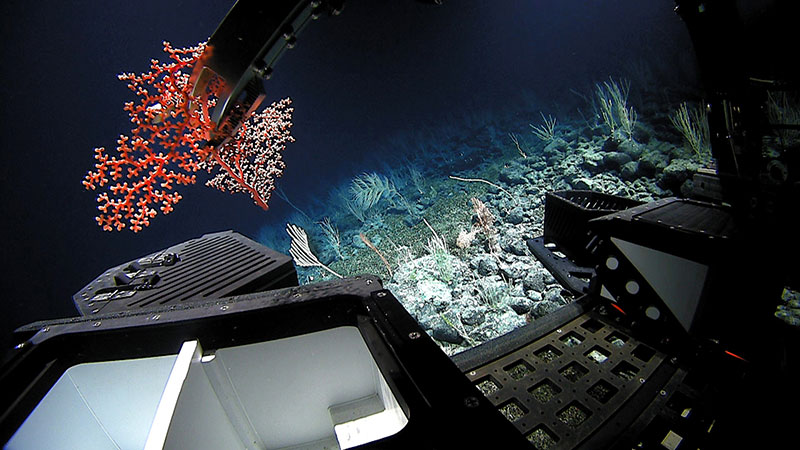
By Daniel Rogers, Global Foundation for Ocean Exploration
March 5, 2016

Deep Discoverer deployment! Image courtesy of the NOAA Office of Ocean Exploration and Research, Hohonu Moana 2016. Download larger version (242 KB).
Nine-thousand pounds of equipment. Over 3,000 feet of electrical wiring. Twenty LED lights. Nine video cameras. Depths of nearly four miles and pressures almost 600 times that at sea level. Impressively large numbers that describe just a few features of NOAA’s remotely operated vehicle (ROV) Deep Discoverer (D2)—our portal to the deep sea.
Exploring the bottom of the ocean requires a talented and professional team with access to the best in deep submergence technology. Through a unique partnership between NOAA’s Office of Ocean Exploration and Research (OER) and the Global Foundation for Ocean Exploration (GFOE) , highly skilled engineers and technicians operate, enhance (or improve), and maintain Deep Discoverer. The “Engineering Team” includes personnel with diverse skills in mechanical, electrical, software, and video engineering, making them well equipped to tackle the difficulties of exploring the normally inaccessible depths of the ocean. The partnership also provides opportunities for training the next generation of engineers and technicians to work side-by-side with experienced personnel.

ROV Engineering Team with ROV Deep Discoverer. Image courtesy of the NOAA Office of Ocean Exploration and Research, Hohonu Moana 2016. Download larger version (2.8 MB).
The Engineering Team works primarily out of NOAA’s Deep Submergence Lab in Quonset, Rhode Island—the port that NOAA Ship Okeanos Explorer calls home. The Okeanos Explorer is the only U.S. government ship dedicated solely to ocean exploration and is the platform from which Deep Discoverer and its sister vehicle, Seirios, are operated.
Referred to in the industry as a ‘camera sled’, Seirios is directly tethered to the Okeanos Explorer by a six mile-long steel cable. It serves to illuminate D2 from above, provide ROV pilots with a wide-angle view of the bottom, and absorb the heaving motions of the ship at the surface so that D2 can safely traverse over sometimes treacherous terrain miles below. Seirios is currently supported by one high-definition camera, one wide fisheye ‘bubble’ camera, and several standard-definition cameras that provide pilots with situational awareness while exploring dark marine environments.

ROV Seirios on deck after a successful dive. Image courtesy of the NOAA Office of Ocean Exploration and Research, Hohonu Moana 2016. Download larger version (903 KB).
The Engineering Team engages in projects designed to expand Deep Discoverer’s capabilities and diversify its data collection portfolio. This includes the addition of new sensors and cameras as suggested by the ocean science community. D2 is already providing scientists with high-quality imagery and seawater data that give us valuable insight into complex underwater ecosystems. The high-definition cameras installed on Deep Discoverer are certainly one of its defining features; the ‘Zeus Plus’ made by Insite Pacific is capable of zooming in on a three-inch long organism from 10 feet away, bringing us closer than ever to the seemingly alien biology and geology of the deep sea.
The Engineering Team recently installed a specialized robotic manipulator arm to collect deep-sea samples, giving scientists an even better look into these environments when they are brought to the surface. Team members have trained for many hours to use this 'Predator II' robotic arm made by Kraft TeleRobotics. It is controlled by manipulating a miniature model of the arm whose movements are mimicked by the full-sized version at the bottom of the ocean. The fine level of control that this manipulator offers allows our pilots to clip small sections of generally fragile coral branches and minimize the impact on the rest of the colony.

Port-side biological sampling bin open to receive a coral sample. Image courtesy of the NOAA Office of Ocean Exploration and Research, Hohonu Moana 2016. Download larger version (1.1 MB).
Modern communication technology connects the Okeanos Explorer and D2 to the rest of the world via satellite by transmitting video from the ROV at the bottom of the ocean to your Internet browser in 30 seconds or less. The satellite antenna and video feeds are supported by the Engineering Team’s video engineers who also control the cameras onboard the ROV during operations. This ensures that images we capture and the content we produce are of broadcast quality. This ‘telepresence’ technology allows onboard scientists to interact with dozens of others worldwide who provide scientific context in real-time while we are at sea. Scientists and videographers are instrumental in guiding our ROV pilots along the seafloor and identifying species that are worth collecting and/or imaging.
The ability to broadcast high-quality images from the bottom of the ocean requires an expertly choreographed production between the Engineering Team, NOAA ship crew, and passionate academics both onboard and onshore. To see for yourself the result of these impressive feats of engineering and cooperation, be sure to tune in to the live feed during one of our several annual ROV expeditions.